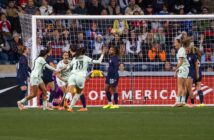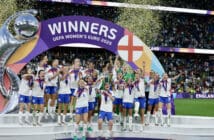No one could have believed a year ago today that a man without any senior managerial experience would be given the job of leading the England Women’s National Team. Chelsea captain Katie Chapman seemed to sum up many people’s surprise at Phil Neville’s appointment. “Surely there must be coaches out there who’ve had a lot more experience in the women’s game, and of actually being a manager?”
Looking back on his first 365 days in the job, former Charlton Athletic Women’s and Estonia coach Keith Boanas believes Neville’s playing career helped make up for any shortfall in his coaching credentials. “There can be no doubting that the experience gained both as a player under the guidance of Sir Alex Ferguson and then his apprenticeship as a coach with professional men’s clubs gave him a great base to work from. This alone would have gained respect from the players very quickly and if you have that, then you can move forward”.

Phil Neville was appointed England manager last year without any senior managerial experience. Picture: Asif Burhan
In twelve months he has used 34 players in 12 matches that have brought seven wins, three draws and two defeats. A thumping 4-1 win over the World Cup hosts, France, in his first match was followed by a disappointing home draw with Wales which put automatic qualification in doubt until a place in the finals was secured by a 3-0 win in the return fixture. However, a home defeat to Sweden in their last match of the year rekindled doubts over whether England had moved on from the team which reached the semi-finals of their last two major tournaments.
Sophie Lawson, an international women’s football journalist, believes that last performance highlights familiar concerns about the Lionesses. “The issues that plagued Mark Sampson’s team are still there, England still can’t break defensive teams down. They routinely look short on answers to basic questions their opposition pose.”
Looking ahead to the World Cup, Boanas believes, “the challenge for Phil will be finding the players who can maintain a consistency and moulding them into a squad that will peak at the right time. It’s a cliche I know, but a balance of experience and youth, calm heads with hungry and fearless players”.
Attempting to find this balance between those who have served England so well for a decade and those who’s impact could turn them into potential champions, Neville, drawing on his own playing experience, has looked to slowly introduce players who have gone through the age-group pathway. “There’s got to be a plan. Whenever I got into the first team at Manchester United, I didn’t play at Stamford Bridge because the boss wanted to protect me, you’ve got to protect young players”. Of the 28 players Neville took to Qatar last week for a warm-weather training camp, 19 survive from his first squad which travelled to last year’s She Believes Cup. He has lost his vice-captain, Jordan Nobbs, to a long-term injury which will unfortunately keep her out of the World Cup. England’s most capped footballer, Fara Williams has been supplanted in midfield by Lucy Staniforth and Georgia Stanway. Goalkeeper, Siobhan Chamberlain has lost her place to the younger Mary Earps and Ellie Roebuck, Anita Asante replaced by the recalled Rachel Daly and the addition of Abbie McManus and Leah Williamson in defence.
According to Boanas, “he has experimented well and looked at options including young players. There was in the past that old guard stigma much like in the men’s team, but more for the fact the options were not there. Now, there are far more ambitious, exciting young talents breaking through, two or three players in literally every position of a similar level”.
Ahead of his first match last February, Neville implemented his first tactical switch moving striker Fran Kirby into midfield, the position in which she is now listed. “It took probably two or three days to convince her and she went out against France and she was sensational. Wherever he can get Fran Kirby on the ball to do her best work is where we’ll play Fran Kirby. I want multi-functional players in this team”.
Lawson however is unsure whether the right players are being properly integrated into the squad, “journalists and fans alike have welcomed the newer faces like Lucy Staniforth and Lauren Bruton, but it still feels that those who deserve to be in the squad on form and merit aren’t getting a respectable look. The further worry is that he’s trialling players like Staniforth out of position and persevering with something that doesn’t work”.
Of the new players, it is Man City Women’s Georgia Stanway, the star and top goalscorer of the Young Lionesses u20 World Cup last summer who Boanas believes is the closest to forcing her way into Neville’s starting team. “She has great technical ability and game understanding but also a touch of arrogance and aggression about her that, if controlled, adds together to make a real winner”.
Inheriting a team that finished third in the world four years ago, there can be no doubt that expectations on Neville’s Lionesses are elevated. The FA’s investment in the team alone justifies results on the pitch. Like his predecessor Neville is adamant that England will be the best prepared team in the tournament but Lawson feels that this may not be sufficient to win it. “It always feels like those not in England will put the Lionesses in the mix as a team to go far – too heavily invested in to be a dark-horse but a side with semi-final potential – and why not, given their recent tournament record? But, from watching this team play, I feel they are eleven players still trying to feel things out on the pitch. They’re all full-timers so the rigours of a tournament shouldn’t see them fall away based on a lack of conditioning but the lack of style, of substance?”
“There is little to suggest what is being put together is a team of champions. A good draw and this side will clear a hurdle or two but there is always a smarter team out there and that will derail the Lionesses”.
England
Women's Football
![Prost International [PINT]](https://prostinternational.com/wp-content/uploads/2021/08/PINTtFontLogoRoboto1536x78.jpg)



